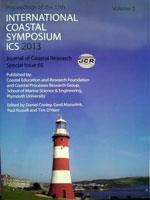Pupienis, D., Buynevich I.V., Jarmalavičius, D., Žilinskas, G., and Fedorovič, J., 2013. Regional distribution of Heavy-mineral concentrations along the Curonian Spit coast of Lithuania
Heavy-mineral concentrations (HMCs) in coastal sands serve as important indicators of hydrometeorological and sedimentological conditions. Along the southeast Baltic Sea coast, quartz- and feldspar-rich sands contain variable amounts (1–8%) of heavy minerals, such as garnet, rutile, zircon, magnetite, ilmenite, hornblende, and other accessory minerals. Their concentrations are found along the Baltic Sea coast of the Curonian Spit, a 98-km-long barrier divided between the Russian Federation (47 km) in the south and the Republic of Lithuania (51 km) in the north. The open sea beach sites range from 25 to 80 m in width and are backed by 5–16 m height foredunes. To examine the patterns in HMC distribution, a total of 303 surface sand samples were collected from the middle of the beach, foredune toe, and stoss slope at 500 m intervals along the entire length of the Lithuanian section. To characterize the relative concentrations of heavy minerals (especially ferrimagnetic), a Bartington MS3 field scanning sensor was used for rapid and effective measurements of low-field volume magnetic susceptibility (MS). Along the Baltic Sea beach, in-situ MS values of κ< 50 μSI of background quartz-rich sands contrast with κ > 150 μSI in surface HMCs. On the beach, MS averages 38 μSI, whereas on the foredune toe and stoss slope they decrease to 33 and 26 μSI respectively. Furthermore, alongshore variations in beach HMC characteristics follow a cyclic pattern with a wavelength of approximately 10 km. This pattern is likely related to wave runup during major storms, whereas on the foredune toe and stoss slope, HMCs reflect the secondary reworking by aeolian processes. Along the sectors with higher MS, coastal erosion processes dominate (Pervalka-Nida), whereas low values generally correspond to regions of sand accumulation (Kopgalis-Pervalka). Therefore, surficial HMCs have the potential for characterizing long-term patterns of regional distribution of hydrodynamic energy along drift-aligned sandy coasts.





